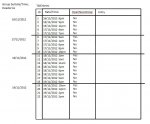Hi everyone,
I have a table called tblEntries which is a simple log table.
I want to create a report with a custom date range for each group. Each group has an irregular interval so i have created a field called "OpenNewGroup" for the user to specify if the entry belongs in a new group.
I have created a simple illustration that i drew up to illustrate my question.
So is there a way that the report can refer to this "OpenNewGroup" field and group all records under it within a group until the next "OpenNewGroup"?
I have a table called tblEntries which is a simple log table.
I want to create a report with a custom date range for each group. Each group has an irregular interval so i have created a field called "OpenNewGroup" for the user to specify if the entry belongs in a new group.
I have created a simple illustration that i drew up to illustrate my question.
So is there a way that the report can refer to this "OpenNewGroup" field and group all records under it within a group until the next "OpenNewGroup"?

